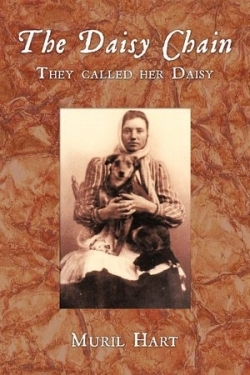The Daisy Chain
They Called Her Daisy
Buddhist writer and philosopher Thich Nhat Hanh once said, “If you look deeply into the palm of your hand, you will see your parents and all generations of your ancestors. … You are the continuation of each of these people.” In a sense, this is the idea behind octogenarian Muril Hart’s biography of her grandmother.
The Daisy Chain is divided into three parts. The first tells the story of Dazerine McIntyre, also known as Daisy, as she is remembered by her daughter Lillian. When Daisy’s husband dies in 1912, she is the mother of four children and faces serious debt. At this time, women were discouraged from working and Daisy has little education and few resources. A strong woman, Daisy soon discovers how to make her way.
In the book’s second part, Hart recounts her own memories of Lillian and Daisy, while the third part provides a short genealogy of Hart’s other ancestors. Hart wrote The Daisy Chain to bring her family “closer to an understanding of their forebears and give them a better grasp on the roots from which they stem.” She has produced a treasure trove of photographs, remembrances, and personal history.
Beyond friends and family, readers may struggle to feel emotionally involved in the Hart family story. To garner greater interest from a general audience, the author should have tapped into the dramatic arc of her family’s biography. Hart’s anecdotes suggest a compelling story exists, but her book does not fully explore it.
Nonetheless, The Daisy Chain is an interesting piece of history. The first two parts of the book capture a snapshot of everyday American life through the first half of the twentieth century. While the narrative sometimes jumps back and forth, Hart’s discussion of events like childhood polio, an urgent surgery on the dining room table, and life on the home front during World Wars I and II might provide details unfamiliar to readers with only a general knowledge of American history.
Gender studies scholars may also find the narrative fascinating. Through Hart’s words, one feels Daisy’s desperation for honest work, her anger when welfare services tries to take her children, and her fear when illness leads her to quickly arrange her daughter’s marriage.
Hart’s family members now have a firsthand narrative of their origins and general readers are sure to find something of interest in this snippet of twentieth-century life told from one family’s unique perspective.
Reviewed by
Katerie Prior
Disclosure: This article is not an endorsement, but a review. The publisher of this book provided free copies of the book and paid a small fee to have their book reviewed by a professional reviewer. Foreword Reviews and Clarion Reviews make no guarantee that the publisher will receive a positive review. Foreword Magazine, Inc. is disclosing this in accordance with the Federal Trade Commission’s 16 CFR, Part 255.

